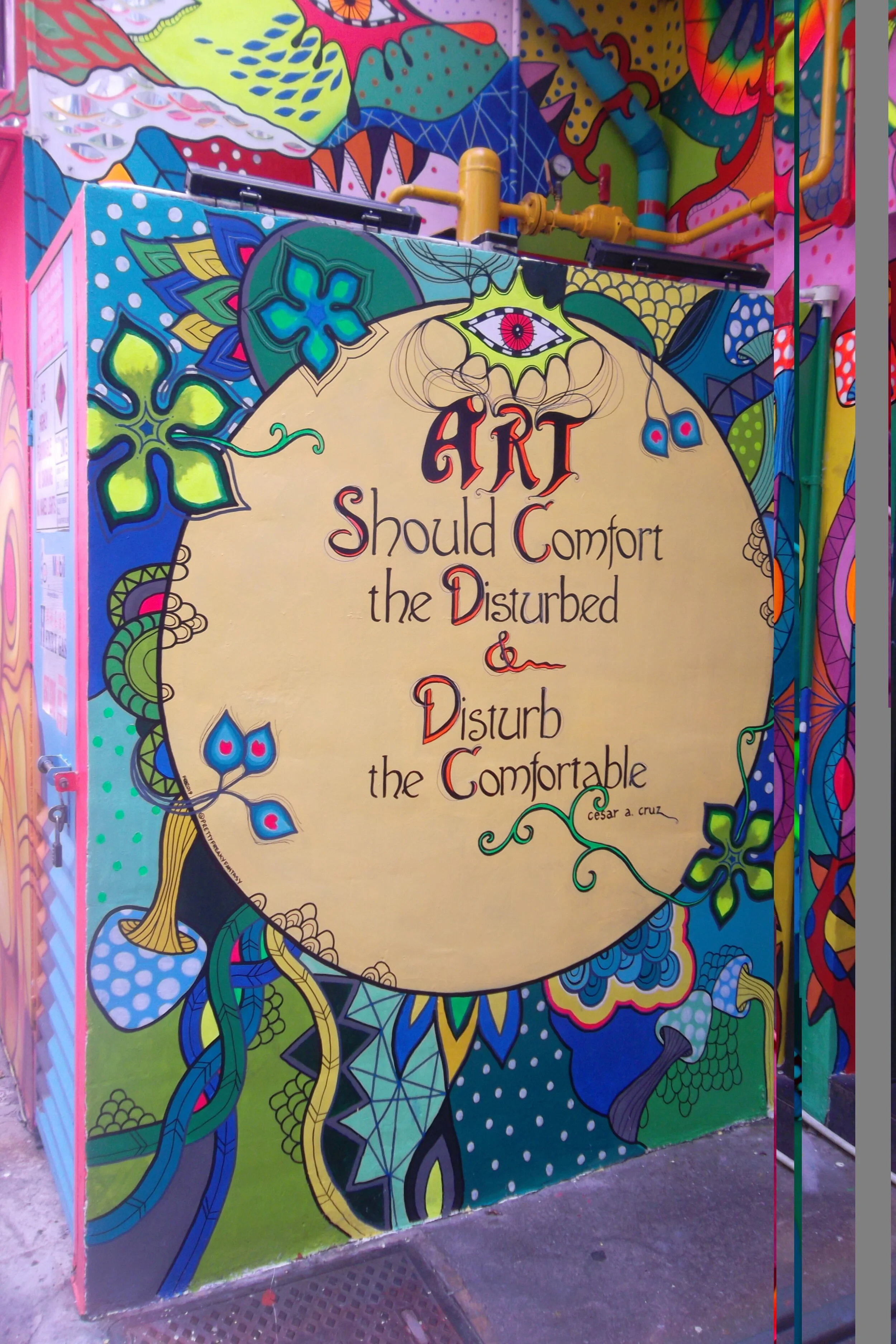High culture can't assume it has an audience in the digital era
When I read this article (Tutti Frutti Gimmicks and the Instagram crowd - Why I'm Breaking Up with the NGV) I felt immensely pleased, because it matched a feeling I have had for quite a while now, but haven’t been able to put into words. Mr Bantick’s article basically poses the question “Why does this exhibition need to be "relevant"? And who is it trying to be relevant to?”
One way to look at it is that Western culture generally used to be much more formal than it is now, Australia included. This had impacts upon culture along with everything else. There used to be talk of “high culture” and “low culture”, and in that much more formal world, they catered to different audiences in a hierarchical manner. The differences between the two still exist to some degree in economic terms – broadly speaking, there are not many people on welfare who visit the opera or the yacht club, nor are there many billionaires who spend their time watching greyhound racing or monster trucks.
Many activities historically conferred social status, something which remains important to most human beings. Most human cultures have this psychological drive; indeed, there is even an academic literature around the idea of “cultural capital”. But what has changed is that some of these activities no longer provide social status for increasingly large swathes of the population. When people no longer aspire to these activities, such change is often disturbing to people who behaved in line with the social codes that went along with it. To learn that all of the the effort they have put into understanding how these activities and social codes worked (and its perceived social cachet) is no longer valued comes as a shock to many.
A secondary flow-on effect is that for many activities, the audience that they have always assumed existed is no longer reliable. There’s several reasons for this; there is now much more competition for people’s time and attention. And the second is the social side of things – if there is no longer any social payoff for attending particular events, locations or activities, then people may no longer feel any pressing need to do so. In turn, this trend often means that the funding streams dry up. Less donations mean that organisations turn to governments, who understandably, look for numbers to support the case that they should fund this project or institution as opposed to something else. And, given that democratic governments are (at least in theory) about everyone, then these numbers inevitably come down to “how many people (votes) do this project touch?”
So the NGV, along with amateur theatres, local historical societies, and countless other organisations, find themselves in a bind. If they keep doing what their previous (analogue-era, Anglo-Saxon, generally older) audiences want, they will find that their audience either gradually shrinks – or it vanishes rapidly without much warning.
On a broader scale, then, how do these organisations show that they can move with the times?
Often the first thing to slide is the dress code. Men no longer need to wear hats, or suits, and baseball caps are often accepted inside.
Secondly, instead of being adult-only zones, many businesses are trying to refit their premises with playgrounds or the like to appeal to families.
Thirdly, to retain staff, instead of the quiet spaces many public places used to be, virtually all cafes and restaurants now have background music. It’s not there for the patrons; it’s there for the young staff who otherwise get bored.
Fourthly, changes in what’s considered appropriate behaviour for both children and adults mean that nobody has the authority to police bad behaviour. Staff don’t wish to do so, because they don’t feel their managers will support them; owners and managers don’t want to, because they’re afraid of being sued and vilified online; and other patrons might want to, but feel that no-one else will support them. End result – the standard of behaviour slides, and becomes the norm.
All of this is contributing to a social and cultural version of the “barbell effect”. If you haven’t come across that expression before, I brief it is talking about how the digital era is forcing many businesses across many industries into either end of the economic spectrum; either giant and cheap.competing on price, or high-cost niche players competing on quality and exclusivity. Those who used to occupy the middle ground are shrinking as inequality widens in developed nations. More detail here: https://www.forbes.com/sites/jimblasingame/2017/02/10/beware-the-barbell-effect-unless-youre-a-small-business/?sh=db9ffe37ff46
So I suspect that the NGV is trying, as best it can, to find ways to appeal to both its existing audience (those who know about, and appreciate, Bonnard) and the much larger audience it needs to attract to stay alive 20-30 years from now (who presumably know about Paris-based designer India Mahdavi). To be fair to the NGV, it’s got a really difficult task ahead of it.
On the one hand, how on Earth do you grab the attention of digital natives who are used to things changing every few minutes on their phones? It’s not coincidence that the saying “Pics or it didn’t happen” dates from 2007[1], when smartphones were taking off. So to actually attract these people into the NGV, and for them to be exposed to the work of (for example) Bonnard, then you need to use the right bait – and hence Mahdavi’s background being used as a mash-up. In this case, the Bonnard art could be considered "high culture", and as such, it is valued by people in the know. But it’s clearly not valued by the digital generations, or the NGV wouldn’t need to do this.
On the other hand, Christpoher Bantick has a point. If even somewhere as large as the NGV needs to take its offering downmarket to survive, then what hope is there for anything related to high culture? We already live in a culture where many people under 30 have never heard of Jane Austen, Mark Twain, Henry Lawson, etc, unless they are exposed to such people in school. The artistic Australian versions would be: Eugene Von Guerard, Tom Roberts, Sidney Nolan, Albert Tucker, Albert Namatjira, Clarence Beckett, Margaret Preston, Brett Whiteley, etc.). How do digital natives come to appreciate (and learn from) history if their idea of a “long time ago” is five years back? And how does a society have a common literary/artistic/musical culture if 80% of the population has no idea what came before it on any of these fronts?
This flows through to other aspects of our lives, too:
How do the general public come to appreciate good architecture if every suburb increasingly resembles a noisy, glass-fronted, hard-surfaced smaller version of Bunnings or Big W?
How do we keep heritage buildings (with their very real connection to history) safe from developers if the broader public doesn’t know, and doesn’t understand, why they are important?
How does any society maintain a common framework of etiquette and manners in public spaces if the only people you come across are your own generation, or your own social class?
I'm personally not against the idea of "mash-ups". After all, as Cesar A. Cruz was quoted as saying: "Art should comfort the disturbed and disturb the comfortable[2].”So, I think that the answer to all of this is not what Mr. Bantick suggests. If older NGV members retreat to their castles, and the digital generation remain glued to their phones, then there is no transfer of ideas, no serendipity, no curiousity sparked – and ultimately, no defenders of Bonnard in future generations.
If those who value high culture want it to continue, they have to show other why it continues to be valuable to society as a whole, or it will end up in a winner-takes-all situation. In such a scenario, Picasso, Rembrandt, Monet, Turner, and other world names will get all of the attention and resources – and more localised artists/musicians/playwrights/sports/interests will be marginalised and forgotten.
I can certainly sympathise with Mr. Bantick’s feelings. One reason I enjoy visiting Japan is because that more formal society still appreciates details, quietness, and reflection. Shopping and eating out in Japan is a pleasure, with calm, unobtrusive service provided. Conversations are quiet, and people are cognisant of others around them. I cannot use those adjectives about virtually anywhere I have been in Australia. But Japan in some respects is like a theme park, in that part of its appeal is that it is out of sync with the modern world. Does that mean it should be valued for its uniqueness, or pitied for its decline? And in both cases, what happens to theme parks when their audiences dry up?
What do you think?
[1] https://digitalcultures.net/slang/internet-culture/pics-or-it-didnt-happen/
[2] https://www.linkedin.com/pulse/art-should-comfort-disturbed-disturb-comfortable-can-%C3%BCstertuna.







